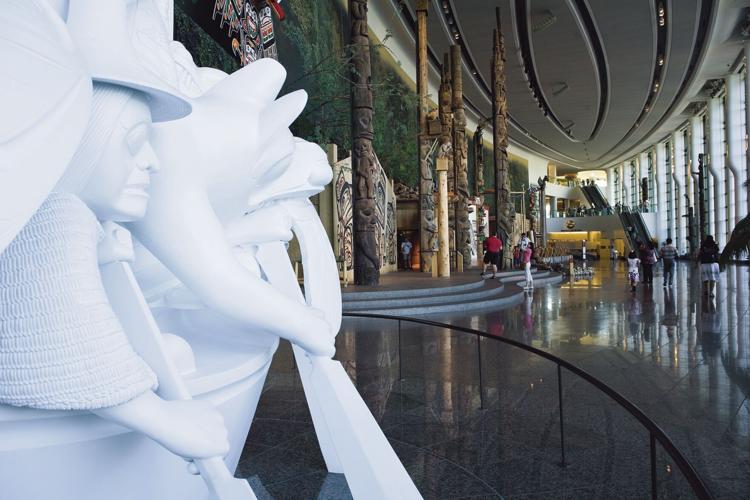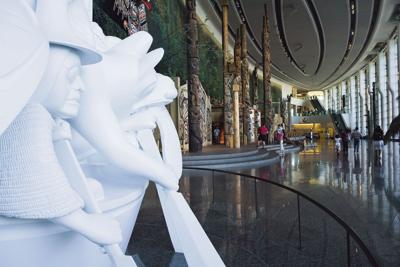For hundreds of years, the Ottawa River was a watery roadway ÔÇö a chemins dÔÇÖeau ÔÇö that allowed Indigenous peoples and later the voyageurs and coureurs des bois to travel and trade. They paddled upstream to the Mattawa River and, after a portage near present day North Bay, onto Lake Nippising, the French River and the Great Lakes. But this road trip is a journey east not west to learn more about French-Canadian culture. It is a voyage through ▓¤│▄├ę▓˙▒cÔÇÖs Outaouais region, the northside of the Ottawa River, eastward to ▓Đ┤ă▓ď│┘░¨├ę▓╣▒˘.
DAY ONE
In the morning: Start your adventure by taking one of the bridges across the river from Ottawa to Gatineau. Head to the Canadian Museum of History, which chronicles the story of this region of North America we now call Canada.
The lower level of the building is dedicated to Indigenous culture, with a grand hall showcasing six traditional houses against a Pacific Coast backdrop, totem poles and the plaster pattern for ÔÇťSpirit of Haida GwaiiÔÇŁ sculpture by Haida artist Bill Reid. Beyond the hall are the exhibits ÔÇťFirst Peoples of the Northwest CoastÔÇŁ and ÔÇťFrom Time Immemorial: Tsimshian PrehistoryÔÇŁ, which are full of historic and contemporary artifacts.
The museumÔÇÖs third and fourth floor are dedicated to the Canadian History Hall, which is designed to guide you from Indigenous creation stories to modern Canada. Among the exhibits are those about the formation of New France and more recent events, including Expo ÔÇÖ67, the October Crisis and the Meech Lake Accord.

The historic Wakefield Mill Hotel and Spa
Ga├źlle LeroyerIn the afternoon: Leaving Gatineau, drive north along Autoroute 5 for half an hour to the picturesque village of Wakefield. Located on the Gatineau River, it is known for its artistic community, and is home to small cafes, pubs, galleries and even a covered bridge. Spend time exploring some of the shops before heading to Gatineau Park, a large wilderness area that is home to hundreds of kilometers of wilderness trails you can hike or bike,
In the evening: Check into the historic Wakefield Mill Hotel and Spa that boasts 40 guest rooms split between the original 1838 building and a modern structure a short walk away. Once settled in, take advantage of one of the treatments at its Holtz Spa in Nature. For dinner, sit in the main dining room of the hotel restaurant, La Muse, and enjoy traditional French and ▓¤│▄├ę▓˙▒cois cuisine, like its rabbit stuffed with foie gras and truffles.
DAY TWO
In the morning: After breakfast at La Muse, drive back toward Gatineau and merge east onto Autoroute 50 toward Montebello. In less than an hour and a half, take the exit for Route 323, but before driving south toward town, drive north a couple of minutes to Parc Omega.
Operating for more than 30 years, the park is home to around 450 wild animals ÔÇô among them bison, caribou, bears and wolves ÔÇö that roam more than 2,200 acres. A series of roadways meander through the park, so you can drive to different areas and watch the animals in a natural setting.

Parc Omega is home to around 450 wild animals ÔÇö among them elk, bison, caribou and wolves.
Ga├źlle LeroyerA popular activity is to buy a bag of carrots from the Park House and feed the elk from your car at one of the first stops along the route. It isnÔÇÖt uncommon to see the animals milling around vehicles as young children wave carrots at them. Drive slowly and take you time so you donÔÇÖt miss anything.
In the afternoon: Follow Route 323 south toward the community of Montebello to enjoy a wood-fired pizza at Le Bistro before walking Rue Notre-Dame and exploring some of its stores and artisanal shops, such as the chocolate makers at Chocomotive and the soaps and beauty products made from lavender at Lavandine et Cie.
Stay at the historic Fairmont le Chateau Montebello, a resort on the bank of the Ottawa River that offers several outdoor activities ÔÇö bikes, outdoor tennis, mini golf and more ÔÇö along with a spa and an aquatic centre with health club.

The central fireplace in the main hall of the Fairmont Le Château Montebello.
Ga├źlle LeroyerThe resort is located on the site of the Seigneurie de la Petite-Nation, an estate once owned by Bishop Montmorency de Laval, the first Roman Catholic bishop of New France. It was later purchased by the Papineau family, and was the home of Louis-Joseph Papineau, who played a role in the Rebellion of 1837 and whose manor house is still located on the property.
The resortÔÇÖs main building was constructed from 10,000 hand-cut red cedar logs from British Columbia and features a central open rotunda with four guest wings extending from it. Originally a private retreat called The Seignory Club, it hosted CanadaÔÇÖs business and political elite, royalty and Hollywood stars. The interior of the rotunda features two upper-level balconies, the walls of which chronicle the propertyÔÇÖs impressive history.
In the evening: Seated at a table in resortÔÇÖs Aux Chantignoles restaurant, start with a bowl of its famous onion soup featuring Montebello cheese before dining on the roasted deer medallion, roasted trout or braised lamb shank. After, enjoy a glass of wine and spend the evening playing complimentary board games around the rotundaÔÇÖs multi-sided central fireplace, its chimney rises 20 metres above the lobby.






























